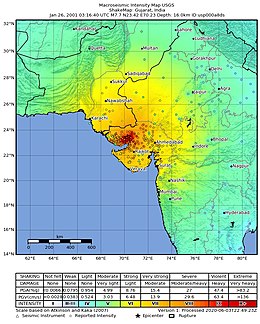2001 Gujarat earthquake
| Earthquake in Gujarat | ||
|---|---|---|
|
|
||
| date | January 26, 2001 | |
| Time | 03:16:40 UTC | |
| intensity | IX – X on the MM scale | |
| Magnitude | 7.7 M W | |
| depth | 16 km | |
| epicenter | 23 ° 25 '8 " N , 70 ° 13' 55" E | |
| country | India | |
| dead | > 20,000 | |
| Injured | 166,836 | |
| damage | US $ 5 billion | |
The Gujarat earthquake on January 26, 2001 at 5:46 am local time was an earthquake disaster in the Indian state of Gujarat that killed more than 20,000 people and left thousands more injured or homeless.
Tectonic background
The epicentral region of the earthquake lies in the west of the Indian plate and consists of multiply folded Cretaceous , Mesozoic and Tertiary rocks covered by Quaternary sediments . The region is traversed by numerous faults running east-west . In the region of the quake, the Indian plate moves northward in relation to the Eurasian plate at a speed of 39 millimeters per year.
Historically, devastating earthquakes from 1668 and 1819 have been documented in the area. The last earthquake before 2001 with an intensity of IX on the Modified Mercalli Scale (MM) occurred in 1956.
The earthquake of 26 January 2001 had a magnitude of 7.7 M W and a focal depth of 16 kilometers. Its epicenter was in the Kachchh district , about 60 kilometers east-northeast of the district capital Bhuj . The hearth process had components of a postponement and a side shift . The area of the hearth was about 90 × 30 km with an east-northeast strike direction . The maximum intensity of the earthquake was at level IX to X MM or at level XI of the ESI scale . The quake was also felt in Bangladesh and Nepal .
In the earthquake, the ground was shaken severely for 85 seconds, followed by a few minutes of slight shaking. Numerous aftershocks occurred, the strongest of which with a magnitude of 5.8 MW .
Victims and damage
The quake shook the ground on the morning of Indian Republic Day . Due to the loose sediment soils, the seismic vibrations were able to develop a particularly destructive effect. At least 20,000 people were killed and 166,836 injured. There were 18 fatalities and some injured in Pakistan . Approximately 339,000 buildings were destroyed and 783,000 were damaged. Almost 1.8 million people were left homeless.
The epicenter of the quake was in the Kachchh district , the capital of which Bhuj was hit very hard. Serious damage was also caused in the cities of Ahmedabad , Anjar , Gandhidham and Mundra, as well as in 8,000 villages.
The port of Navalakhi and its connection to the rail network were severely damaged by soil liquefaction , and there was also damage to the important port of Kandla .
Numerous bridges in the region were damaged. Due to damage to a railway bridge, trains could only be used for aid deliveries after a week. Some earth embankments were damaged.
In the Rann of Kachchh , soil liquefaction occurred over a large area, as a result of which sand volcanoes formed and dry rivers became water-bearing. Landslides and rockfalls were triggered, and cracks formed in the ground.
supporting documents
- ↑ a b c d e f Sambit Prasanajit Naik, Asmita Mohanty, Sabina Porfido, Martitia Tuttle, Ohsang Gwon, Young-Seog Kim Intensity estimation for the 2001 Bhuj earthquake, India on ESI-07 scale and comparison with historical 16th June 1819 Allah Bund earthquake: A test of ESI-07 application for intraplate earthquakes. In: Quaternary International. Volume 536, January 20, 2020, pp. 127-143, doi: 10.1016 / j.quaint.2019.12.024 (English).
- ↑ a b c M 7.7 - Gujarat, India. USGS , accessed August 3, 2020.
- ↑ a b Significant Earthquake: INDIA: GUJARAT: BHUJ, AHMADABAD, RAJOKOT; PAKISTAN. NOAA , accessed August 5, 2020.
- ↑ M 5.8 - Gujarat, India. USGS, accessed August 3, 2020.
- ↑ Emily Buchanan, Bhasker Solanki: Gujarat's astonishing rise from rubble of 2001 quake. In: bbc.com . January 30, 2011, accessed August 5, 2020.
- ↑ a b Earthquake Engineering Field Investigation Team (Ed.): The Bhuj, India Earthquake of 26th January 2001. A Field Report by EEFIT. London January 2005, digital version online (PDF; 9.28 MB) at istructe.org (English).


